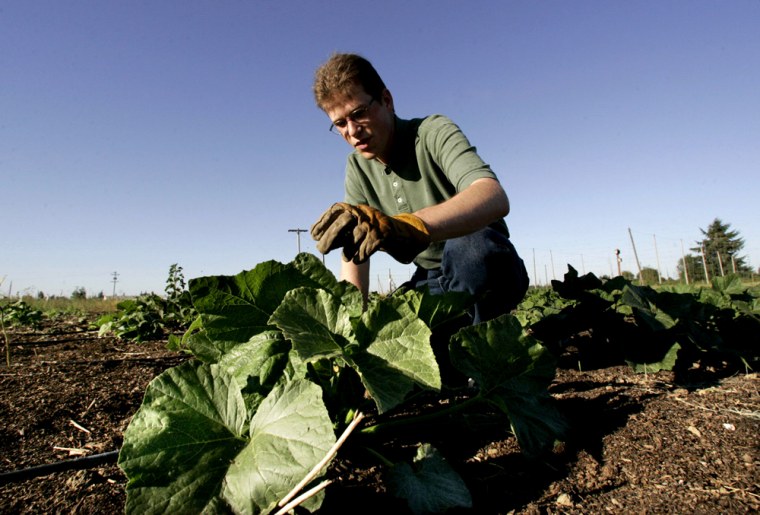Plenty of college kids still subsist on a steady diet of ramen noodles, cold cereal and beer to wash it all down.
Not Nate France. The crop and soil sciences major at Oregon State University here wouldn't dream of following the well-beaten path to the local Carl Jr.'s for cheap, mammoth burgers.
Instead, every Thursday afternoon until the sun sets, France helps till and tend to a pocket-sized, student-run organic farm on a couple of soil-rich acres just outside this western Oregon college town.
“I sowed some corn while it was raining, and then I tamped down the soil too much — it caked up, hard as a brick, and the corn plants couldn't come up,” said France, 27, who dreams out loud about farming his own land someday. “This next time, I know to mix manure in. This is like a trial by fire, a way to make mistakes before it matters too much.”
In the last decade or so, student-run farms have cropped up across the country, at almost 60 schools in 27 states. Foodies call it the latest sign of the seasonal, regional food movement's influence, even on a collegiate landscape that's virtually paved with Hot Pockets, Pop Tarts and leftover pizza.
Over the past few years, about 200 schools have signed up with farm-to-college programs, which match up local farmers with area universities, according to the Venice, Calif.-based Community Food Security Coalition. The University of Montana in Missoula, for example, allocates about $425,000 to local meat, dairy and wheat products, about 17 percent of the school's overall food budget.
At Brown University, in Providence, R.I., dining hall purchasers started swapping Granny Smiths and Red Delicious for locally grown Macouns and Pippins. Apple consumption tripled, and the experiment extended to locally grown tomatoes and peaches, milk from Rhode Island dairies and, eventually, a farmers' market that set up shop outside the dining hall.
“I was carrying a flat of local peaches into the dining hall once, it was like having bread at the beach and having seagulls following me,” said Louella Hill, a recent Brown graduate who helped organize the on-campus farmers' market. “People were grabbing peaches and eating them before I could get to the fruit bowl.”
But student farms, which range from half an acre to 200, turn students themselves into growers.
Some student farmers, like those at Dartmouth College in New Hampshire, sell the fruits of their labor at on-campus farmstands, while the bounty from the University of Idaho at Moscow gets parceled out each week to community members who have prepaid for baskets of whatever's fresh.
Some student farms supply their dining halls with fresh produce, while others sell directly to restaurants. At Colorado State University's student farm, what doesn't get sold on campus or eaten by volunteers is donated to local food pantries.
“I, like students, like the social aspects of working in the garden, and being able to connect with other similar-minded people,” said Debra Guenther, a Colorado State horticulture research associate who helps run the student farm.
In Corvallis, the fat green fava beans, pearly garlic, broccoli and lettuce harvested on a recent Thursday are for sale the next morning at an on-campus, unstaffed booth; payment is on the honor system and helps support the farm.
This time of year rows of tomatoes and eggplants nod in the sun, waiting for their moment in late August, and a tiny patch of strawberries grows nearly wild — just enough for eating, not for selling. After four hours or so of weeding, harvesting and planting, students have a communal meal.
“It's nice during school to be able to go out and get my hands dirty,” said Kevin McAlpin, 22, an Oregon State junior majoring in natural resources who was on his hands and knees weeding a lettuce bed. “It's stress relief.”
Some student farms stretch back decades, but the Oregon State one was begun in 2001. Previous attempts to start a farm had failed when students found that gardening was a year-round job, said James Cassidy, an instructor in the soil physics lab, who has become the group's leader.
Now, Cassidy, a former bass player for the '80s dance group “Information Society” who nourished an interest in soil even as group churned out hits like “Pure Energy,” is an undisputed garden fanatic.
“It's like working in a kitchen,” he said. “Gardening is not a democracy.”
Cassidy dreams of planting canola seeds one day to extract oil to make the biodiesel necessary to power a tractor and of expanding the farm by eight more acres.
“Creative people are coming to this,” he said. “It gives students an opportunity to put a seed in the ground and see what happens.”
